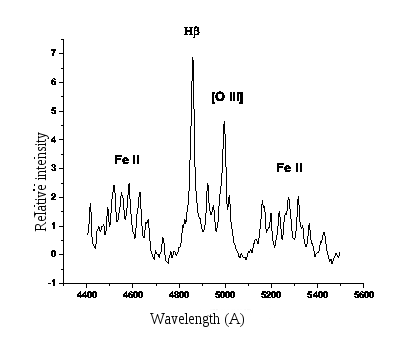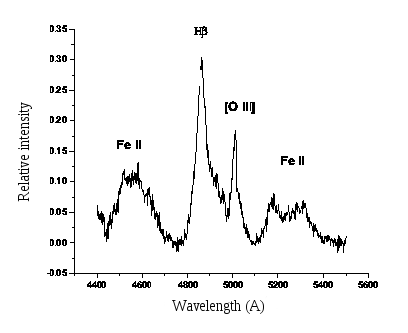Fe II lines in AGN spectra
Optical Fe II (λλ 4000-5400 Å) emission is one of the most interesting features in Active Galactic Nuclei (AGN) spectra.
The emission arises from numerous transitions of the complex Fe II ion.
Fe II emission is seen in almost all type-1 AGN spectra and it is especially strong in narrow-line Seyfert 1s (NLSy1s).
It can also appear in the polarized flux of type-2 AGNs when a hidden Broad Line Region can be seen.
Figure 1 Example of the narrow Fe II emission: Fe II lines in NLSy1 galaxy I Zw 1.

Figure 2 Example of the broad Fe II emission: Fe II lines in
SDSS J134251.60-006000.00.

Since the Fe II ion is very complex, there are numerous Fe II lines, which overlap each other in AGN spectra and forming irregular features (see upper pictures). Also, part of the optical Fe II lines overlap with Hβ and [O III]4959, 5007 Å lines, which makes their analysis even more difficult.
Why Fe II lines are interesting?
There are several unsolved problems connected with Fe II emission: (I) the location of the Fe II emission line region in an AGN is still not clear (several possibilities are proposed), than (II) the mechanisms of their excitation.
Namely, there are suggestions that Fe II emission cannot be explained with standard photoionization models. The additional mechanisms of excitation may have the role to explain the Fe II emission.
(III) Also, there are many correlations between Fe II emission and other AGN properties which need a physical explanation.
Taking this into account we need a good Fe II template in order to:
1. answer to these open questions,
2. investigate Hβ and [O III] lines which overlap with Fe II;
For more see:
§Introduction in paper Kovacevic, et. al, 2010, ApJS..189...15K, (arXiv:1004.2212)